[Esp]Relajación muscular./[Eng]Muscle relaxation.
Cuando concluye la adecuada contracción de un músculo, ocurre el proceso de relajación muscular, de manera que sus fibras retornan a la posición original, tras el cese del impulso nervioso. En el caso contrario, los músculos se ponen tensos, manifestándose generalmente en la espalda y el cuello, debido a varios factores, como el ritmo de vida acelerado en muchas horas de trabajo, en especial sentados, igualmente por problemas familiares, así como también por el poco o escaso tiempo dedicado a la actividad física, traduciéndose en dolencias musculares, en ese sentido, antes de meditar y calentar el cuerpo con moderados ejercicios, propongo una práctica asana que genera una efectiva relajación muscular, contribuyendo a liberar tensiones, en especial en los músculos de las zonas señaladas, dicha postura se denomina Parivrtta Uttan Pristhasana o la variante de la postura del lagarto.
La anunciada asana, se realiza de la siguiente manera; ubicados en la posición cuadrúpeda, es decir con el cuerpo apoyado de las manos y las rodillas, adelantamos una pierna ubicándola al lado de los antebrazos, giramos suavemente el torso, dejando apoyado un codo en la esterilla, mientras levantamos la mano, para unirla con la otra, cuyo antebrazo alzamos, colocando luego ambas manos, con los dedos entrelazados en la nuca. La distinguida asana, también es muy buena para estirar los músculos de las piernas y los brazos, fortalece los músculos de la columna vertebral y del abdomen, equilibra el cuerpo, reduce el estrés y calma la mente. Amigos, acompáñenme en el desarrollo de tan importante asana y demostremos sus destacados beneficios para la salud. Éxitos.
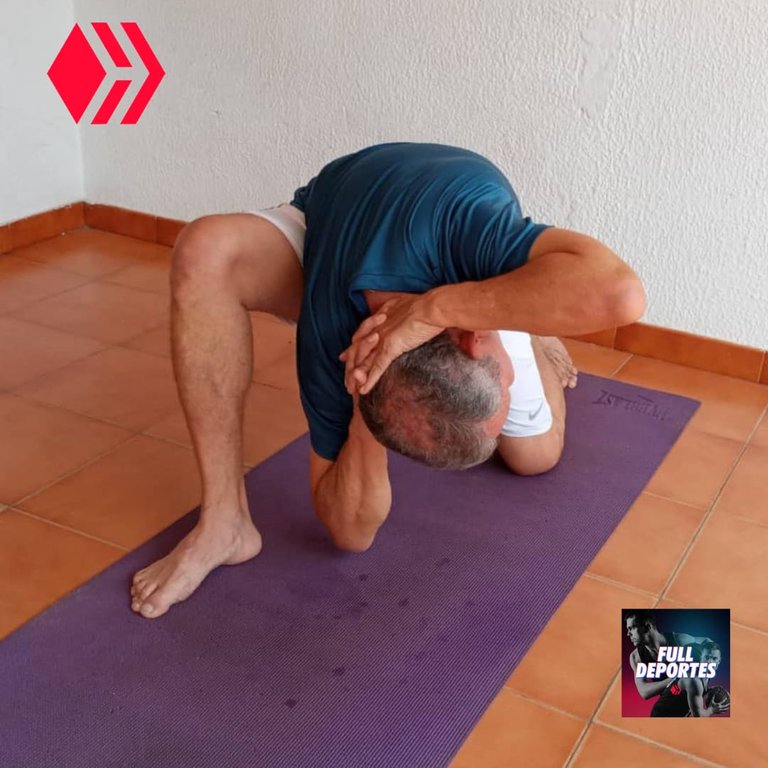
When the proper contraction of a muscle ends, the process of muscle relaxation occurs, so that its fibers return to their original position, after the cessation of the nerve impulse. In the opposite case, the muscles become tense, usually manifesting in the back and neck, due to several factors, such as the accelerated pace of life in many hours of work, especially sitting, also due to family problems, as well as due to the little or scarce time dedicated to physical activity, resulting in muscle ailments, in that sense, before meditating and warming up the body with moderate exercises, I propose an asana practice that generates effective muscle relaxation, helping to release tension, especially in the muscles in the indicated areas, this posture is called Parivrtta Uttan Pristhasana or the variation of the lizard posture.
The announced asana, perform as follows; located in the quadrupedal position, that is, with the body supported by the hands and knees, we advance one leg placing it next to the forearms, gently rotate the torso, leaving an elbow on the mat, while we raise the hand, to join it with the other, whose forearm we raise, then placing both hands, with the fingers intertwined at the nape of the neck. The distinguished asana is also very good for stretching the muscles of the legs and arms, strengthens the muscles of the spine and abdomen, balances the body, reduces stress and calms the mind. Friends, join me in the development of such an important asana and let us demonstrate its outstanding health benefits. Successes.
Proceso de Meditación
Es muy importante meditar, previo al proceso de calentamiento corporal, para relajarnos y calmar la mente, lo haremos simulando la postura que se indica a continuación; sentados con la espalda derecha, las piernas flexionadas, direccionamos los talones de los pies a los glúteos, apoyando las manos en las rodillas, para reflexionar e interanalizar las siguientes ideas: "Nunca somos demasiado viejos, para tener otra meta u otro sueño" y "El optimismo, es la fe que conduce al logro, nada puede realizarse sin esperanzas".
Éxitos.
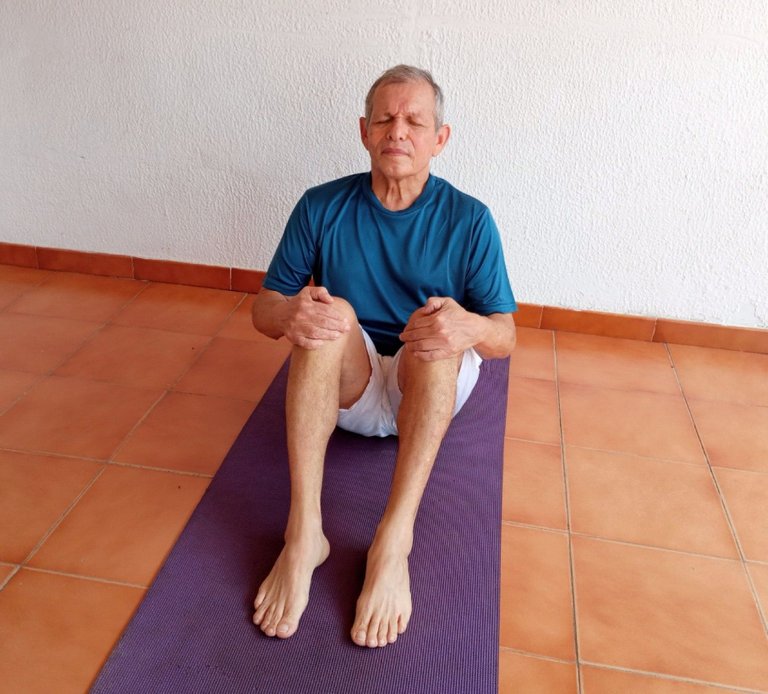
Meditation Process
It is very important to meditate, prior to the body warm-up process, to relax and calm the mind, we will do so by simulating the posture indicated below; Sitting with your back straight, legs bent, we direct the heels of the feet to the buttocks, resting the hands on the knees, to reflect and interanalyze the following ideas: "We are never too old to have another goal or another dream" and "Optimism is the faith that leads to achievement, nothing can be done without hope." Successes.
Ejercicios para calentar el cuerpo
A continuación desarrollaremos una serie de acciones, para calentar el cuerpo, con el objetivo de alcanzar un buen rendimiento, evitar lesiones, flexibilizar los músculos y articulaciones. Los movimientos son muy buenos para equilibrarnos y comenzar a fortalecer los músculos de la espalda, del abdomen y de las extremidades superiores e inferiores, ellos son:
Acostados boca abajo con las rodillas flexionadas, los talones de los pies hacia delante, los codos de los brazos doblados, apoyando las manos en la esterilla y la mirada al frente, extendemos el brazo derecho hacia delante y luego lateralmente, igualmente desarrollaremos el comentado ejercicio estirando el brazo izquierdo adelante y posteriormente en forma lateral. Durando en dichos movimientos 6 minutos, por cada 2 minutos, descansamos 10 segundos. Éxitos.
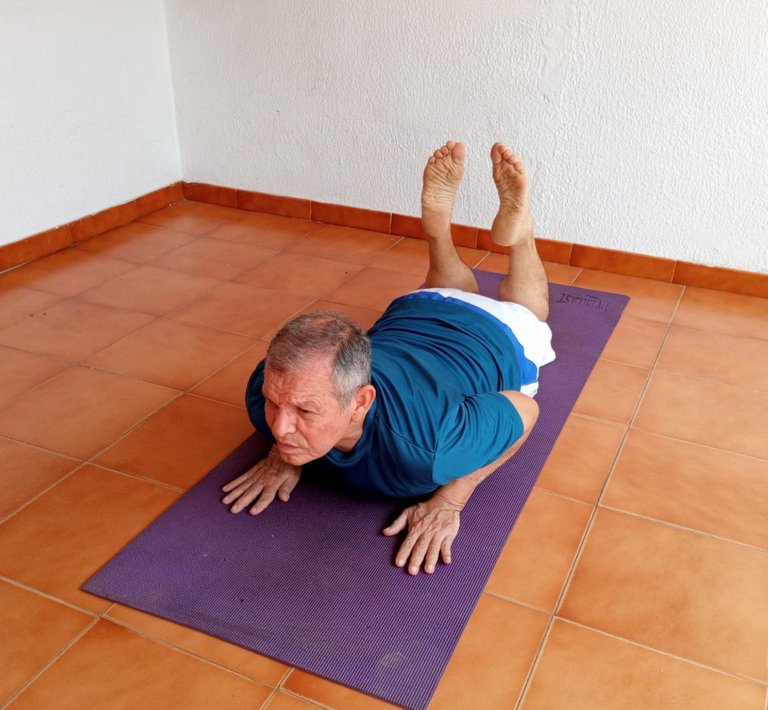
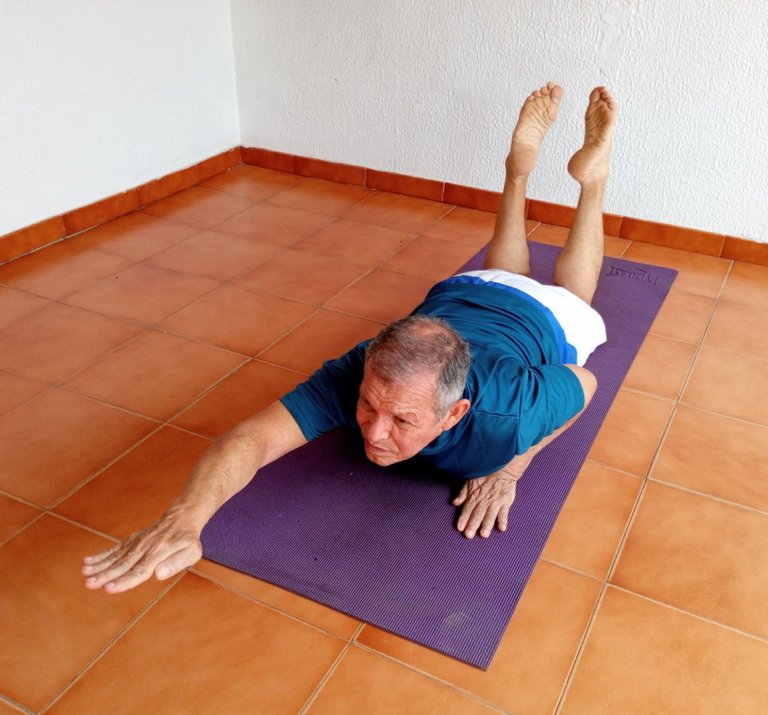

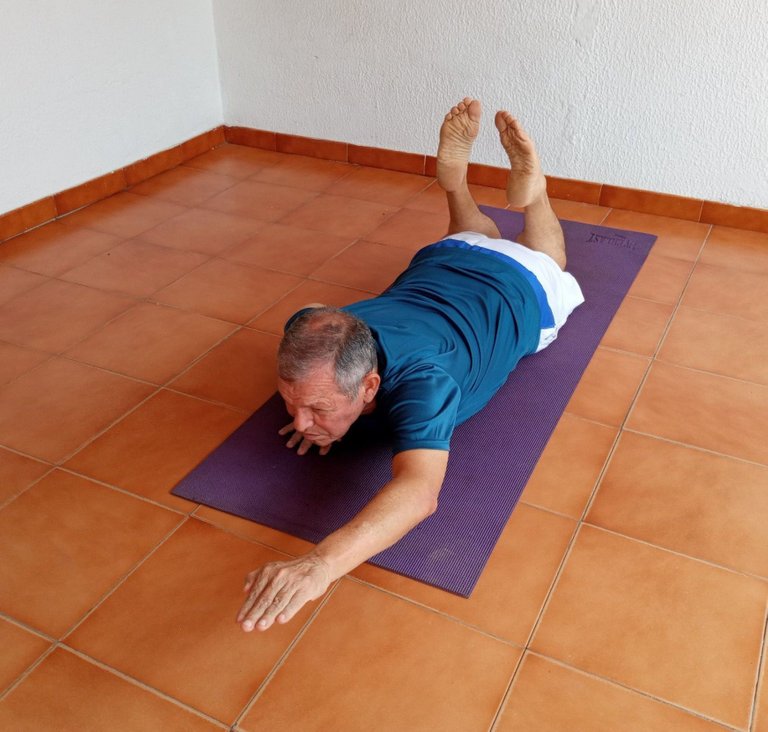
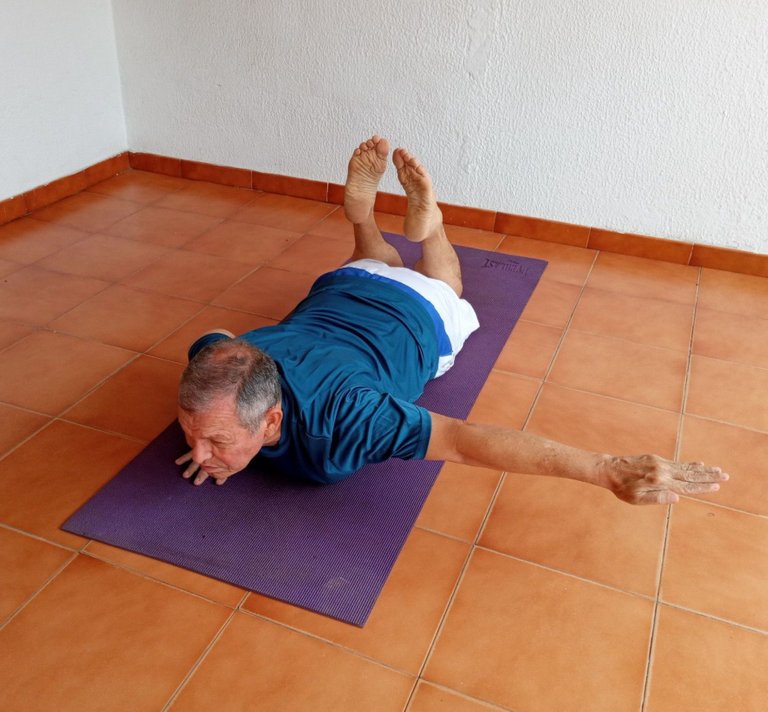
Exercises to warm up the body
Next, we will develop a series of actions to warm up the body, with the aim of achieving good performance, avoiding injuries, and making the muscles and joints more flexible. The movements are very good to balance ourselves and begin to strengthen the muscles of the back, abdomen and upper and lower extremities, they are:
Lying face down with the knees bent, the heels of the feet forward, the elbows of the arms bent, resting the hands on the mat and looking forward, we extend the right arm forward and then laterally, we will also carry out the aforementioned exercise stretching the left arm forward and then laterally. Lasting in these movements 6 minutes, for every 2 minutes, we rest 10 seconds. Successes.
Ubicados en la posición inicial, acostados boca abajo con las rodillas flexionadas, los talones de los pies hacia delante, los codos de los brazos doblados, apoyando las manos en la esterilla y la mirada al frente, llevamos el pie derecho cercano a los glúteos, luego estiramos la pierna derecha hacia atrás, seguidamente acercamos el pie izquierdo a los glúteos y luego estiramos la pierna izquierda hacia atrás. Las acciones descritas, las cumpliremos en 6 minutos, por cada 2 minutos, descansamos 10 segundos. Éxitos.
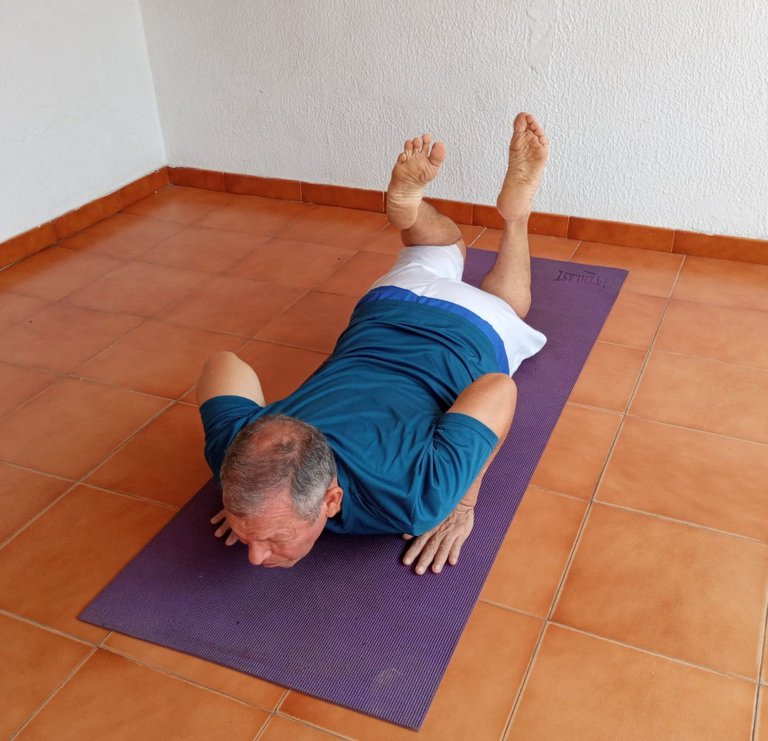
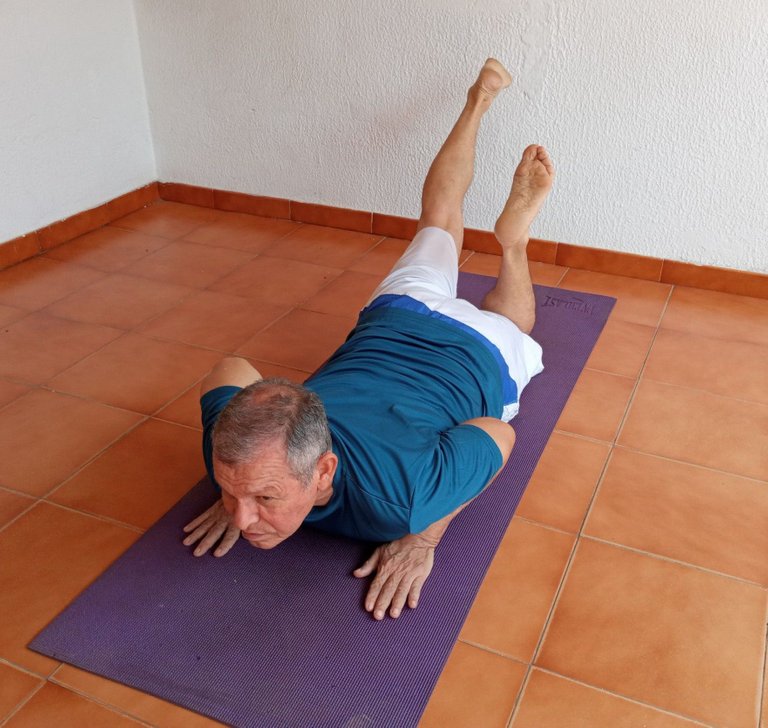
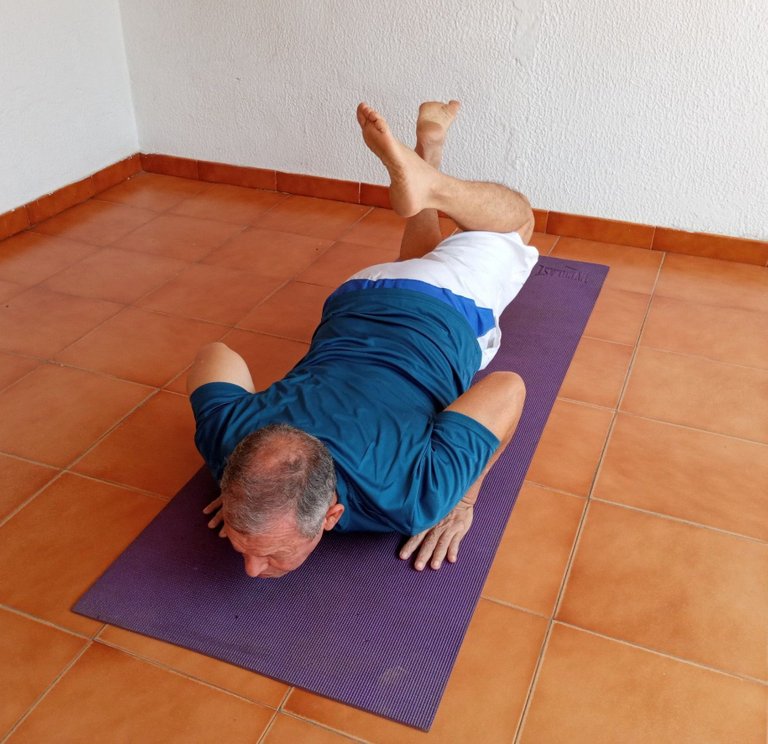
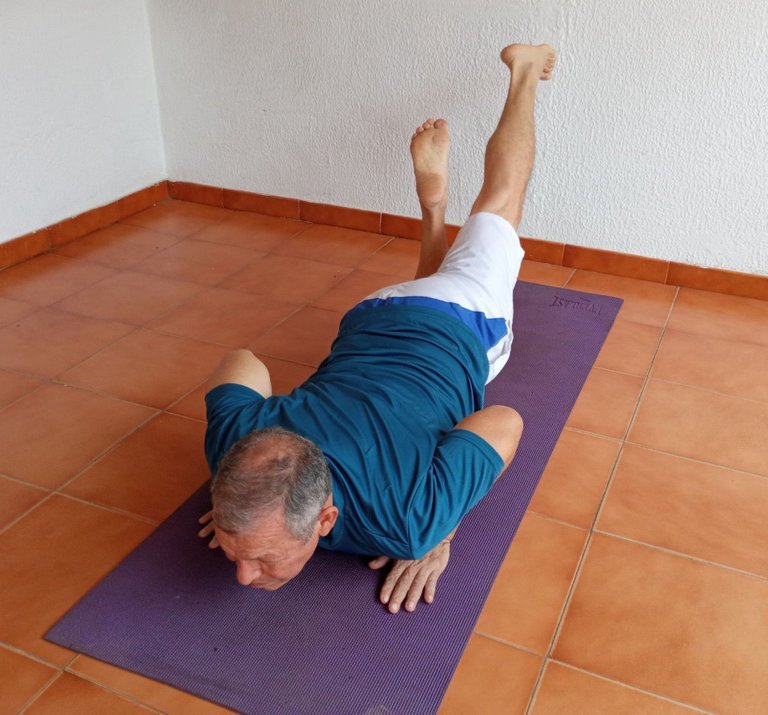
Located in the initial position, lying face down with the knees bent, the heels of the feet forward, the elbows of the arms bent, resting the hands on the mat and looking forward, we bring the right foot close to the buttocks, then we stretch the right leg back, then bring the left foot closer to the buttocks and then stretch the left leg back. The described actions, we will carry out in 6 minutes, for every 2 minutes, we rest 10 seconds. Successes.
Desarrollo de Parivrtta Uttan Pristhasana o la variante de la postura del lagarto, ubicados en la posición cuadrúpeda, es decir el cuerpo apoyado de las manos y las rodillas, adelantamos una pierna ubicándola al lado de los antebrazos, giramos suavemente el torso, dejando apoyado un codo en la esterilla, mientras levantamos la mano, para unirla con la otra, cuyo antebrazo alzamos, colocando luego ambas manos, con los dedos entrelazados en la nuca
Estando en la posición cuadrúpeda, el cuerpo apoyado de las rodillas y de las manos con los brazos estirados, , inclinando ligeramente el peso hacia delante, procedemos suavemente a adelantar la pierna derecha, colocándola al lado de la mano del citado lado, seguidamente sin hacer mucha tensión, doblamos los codos, logrando apoyarlos en la esterilla, conformando la asana del lagarto o Uttan Pristhasana, durando 30 segundos equilibrados inspirando, aguantando y expulsando aire. Éxitos.
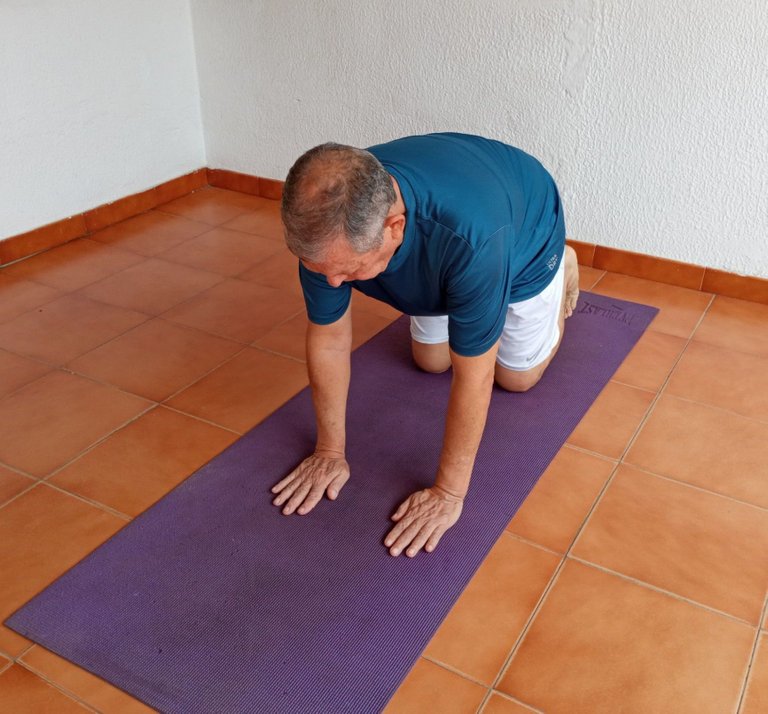
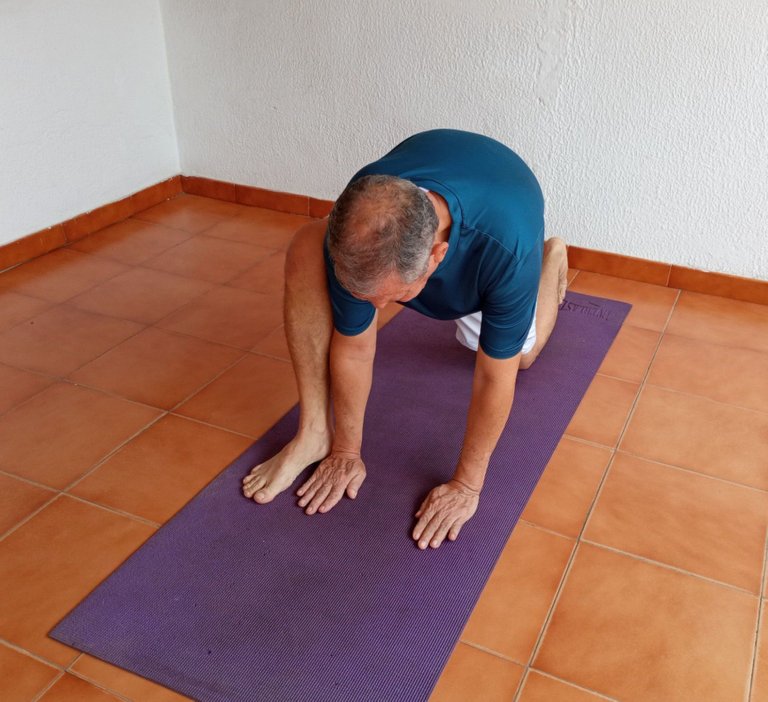
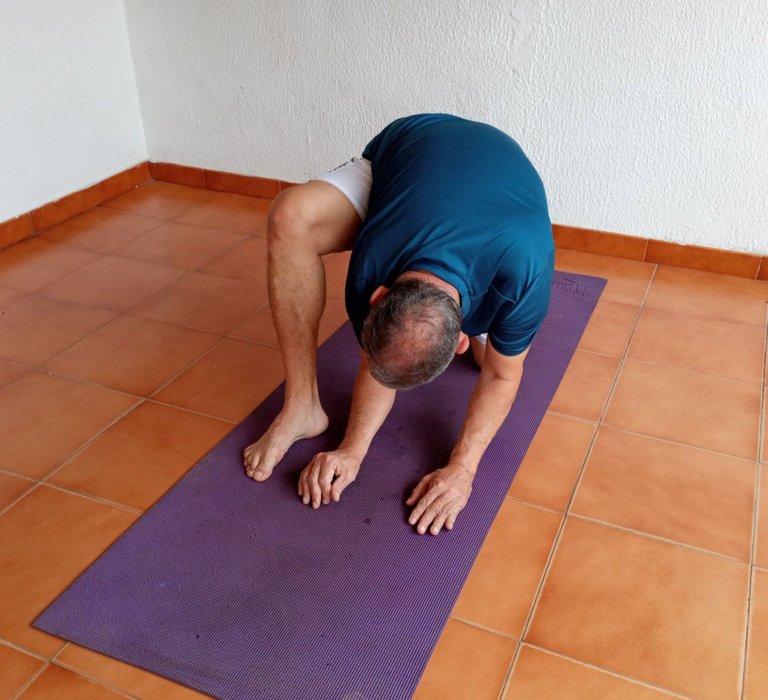
Development of Parivrtta Uttan Pristhasana or the variant of the lizard posture, located in the quadrupedal position, that is, the body supported by the hands and knees, we advance one leg placing it next to the forearms, we gently turn the torso, leaving leaning one elbow on the mat, while we raise our hand, to unite it with the other, whose forearm we raise, then placing both hands, with the fingers intertwined on the neck
Being in the quadrupedal position, the body supported by the knees and the hands with the arms stretched out, slightly inclining the weight forward, we gently proceed to advance the right leg, placing it next to the hand on the aforementioned side, then without doing a lot of tension, we bend our elbows, managing to support them on the mat, forming the asana of the lizard or Uttan Pristhasana, lasting 30 balanced seconds inhaling, holding and expelling air. Successes.
A continuación, manteniendo la pierna derecha adelantada, al lado del antebrazo derecho que continúa apoyado en la esterilla, suavemente flexionamos el brazo izquierdo, llevando la mano hacia la nuca, quedándonos equilibrados y en resistencia corporal, inspirando, aguantando y expulsando aire. Éxitos.
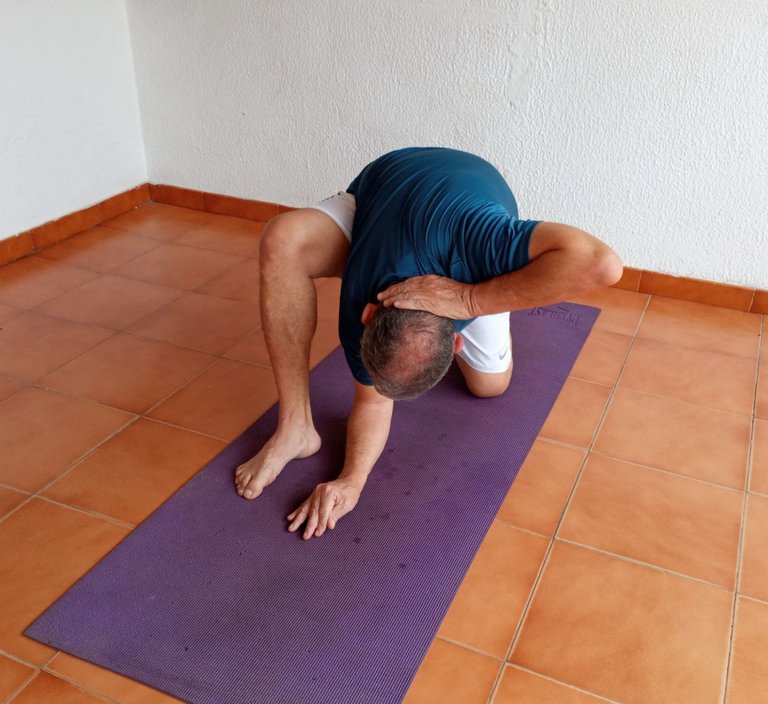
Next, keeping the right leg forward, next to the right forearm that continues to rest on the mat, we gently flex the left arm, bringing the hand towards the neck, staying balanced and in body resistance, inhaling, holding and expelling air. Successes.
Conformamos Parivrtta Uttan Pristhasana o la variante de la postura del lagarto, de la siguiente manera; manteniendo la pierna derecha adelantada, al lado del antebrazo derecho que continúa apoyado en la esterilla, con el brazo izquierdo flexionado cuya mano está en la nuca, sin hacer mucha tensión, suavemente despegamos la mano derecha de la esterilla, dejando apoyada en ella el codo de dicho lado y la llevamos a la nuca, juntando ambas manos en ella, durando en esta asana 30 segundos equilibrados y en resistencia corporal, inspirando, aguantando y expulsando aire. Éxitos.
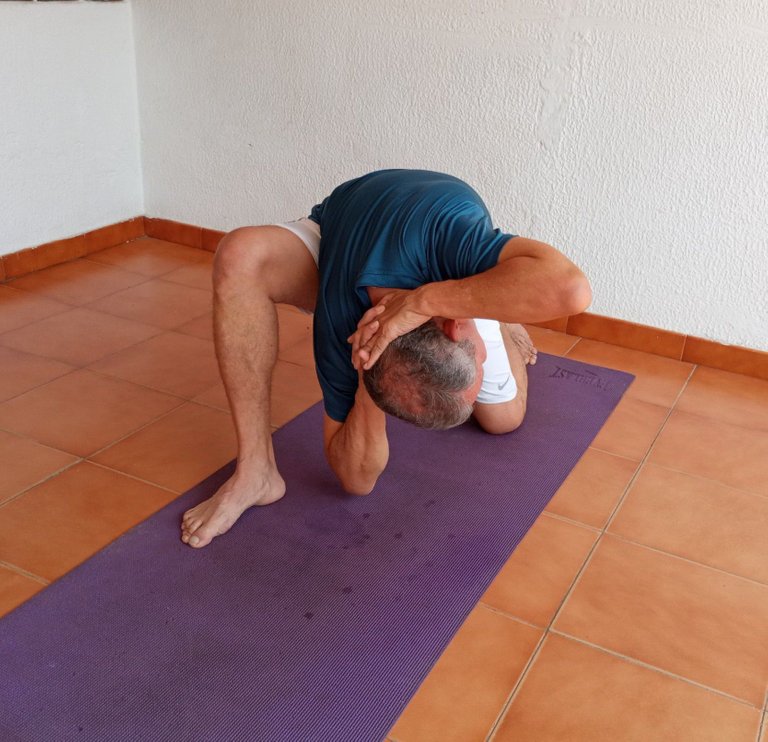
We make Parivrtta Uttan Pristhasana or the variant of the posture of the lizard, as follows; Keeping the right leg forward, next to the right forearm that continues to rest on the mat, with the left arm flexed whose hand is on the back of the neck, without making much tension, gently lift the right hand off the mat, leaving the elbow resting on it. on that side and we take it to the nape of the neck, joining both hands in it, lasting in this asana 30 seconds balanced and in body resistance, inhaling, holding and expelling air. Successes.
Repetimos la asana Parivrtta Uttan Pristhasana o la variante de la postura del lagarto, de la siguiente manera; manteniendo en esta oportunidad la pierna izquierda adelantada, al lado del antebrazo izquierdo que continúa apoyado en la esterilla, con el brazo derecho flexionado cuya mano está en la nuca, sin hacer mucha tensión, suavemente despegamos la mano izquierda de la esterilla, dejando apoyada en ella el codo de dicho lado y la llevamos a la nuca, juntando ambas manos en ella, durando en esta asana 30 segundos equilibrados y en resistencia corporal, inspirando, aguantando y expulsando aire. Éxitos.
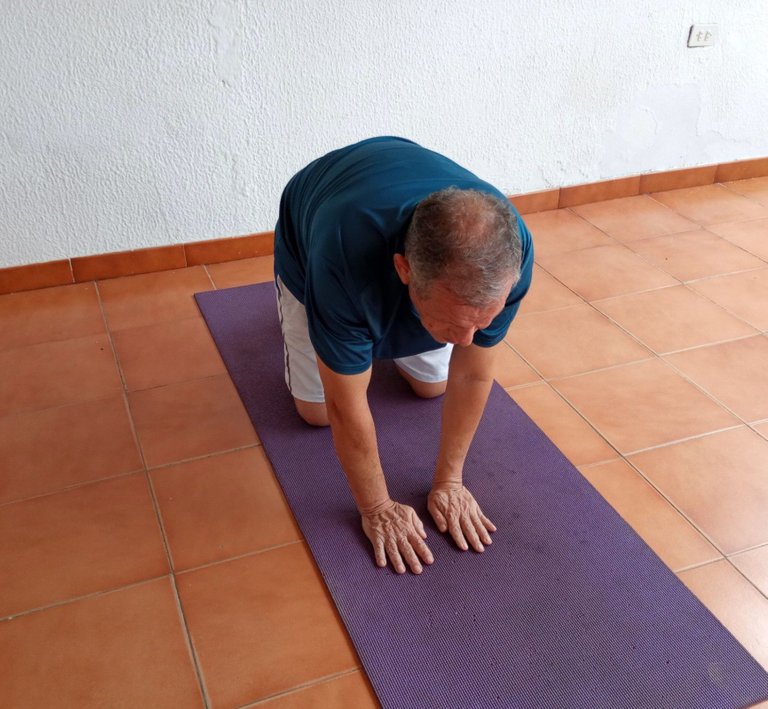
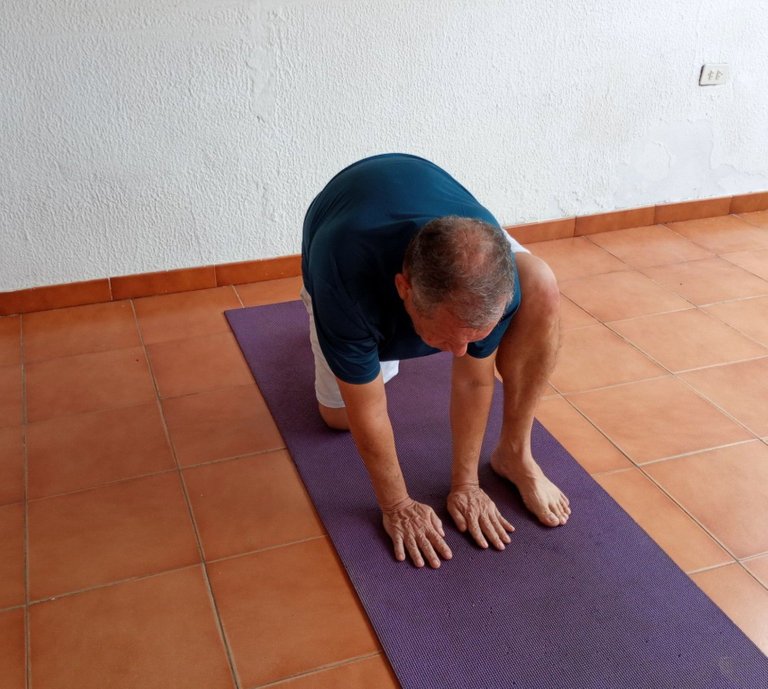
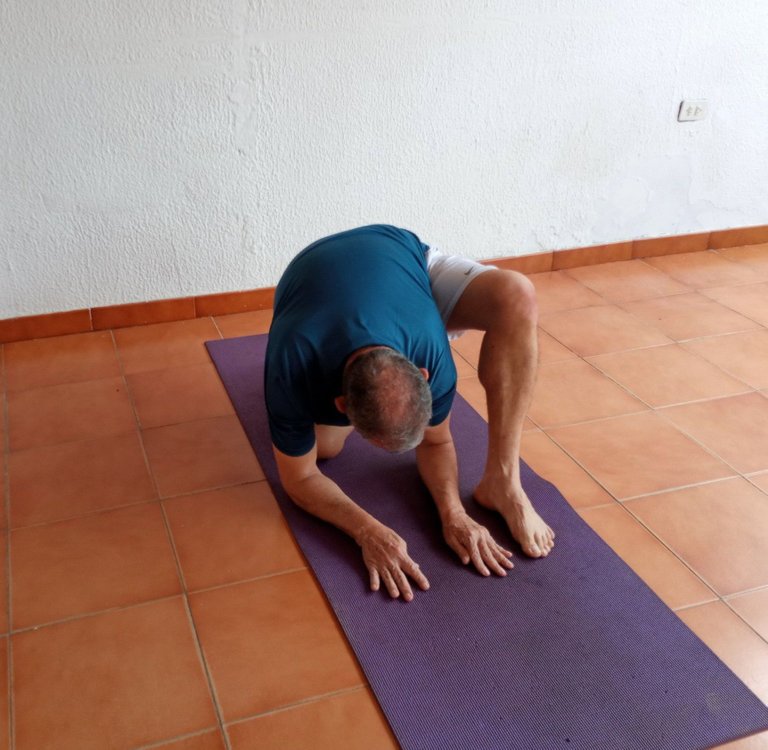
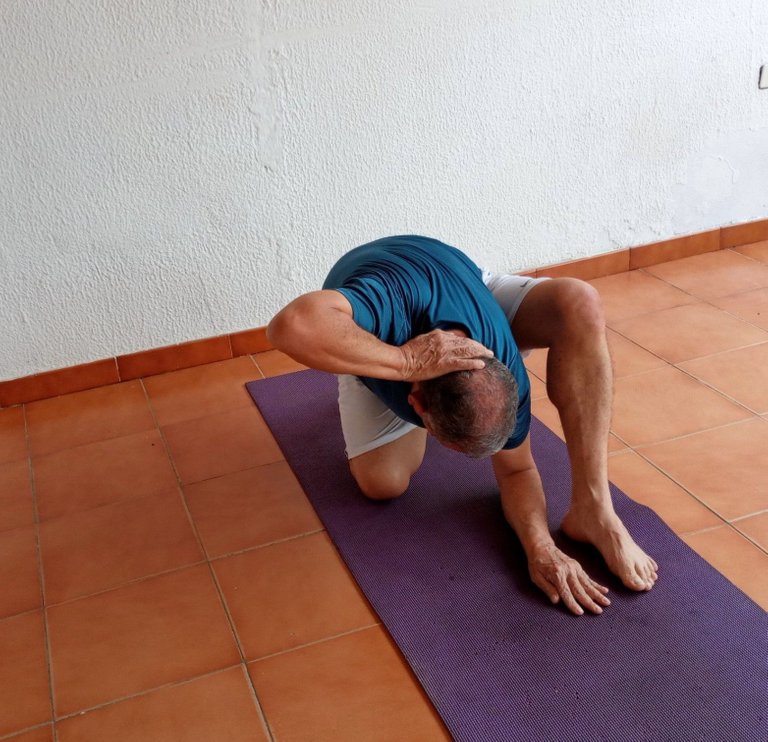

We repeat the asana Parivrtta Uttan Pristhasana or the variant of the lizard posture, as follows; This time, keeping the left leg forward, next to the left forearm that continues to rest on the mat, with the right arm flexed and the hand on the back of the neck, without exerting much tension, we gently lift the left hand off the mat, leaving it resting on the her the elbow on that side and we take it to the nape of the neck, joining both hands in it, lasting in this asana 30 seconds balanced and in body resistance, inhaling, holding and expelling air. Successes.
Beneficios de Parivrtta Uttan Pristhasana o la variante de la postura del lagarto, ubicados en la posición cuadrúpeda, es decir el cuerpo apoyado de las manos y las rodillas, adelantamos una pierna ubicándola al lado de los antebrazos, giramos suavemente el torso, dejando apoyado un codo en la esterilla, mientras levantamos la mano, para unirla con la otra, cuyo antebrazo alzamos, colocando luego ambas manos, con los dedos entrelazados, en la nuca
- Ofrece una efectiva relajación muscular, contribuyendo a liberar las tensiones musculares de la espalda y en el cuello.
- Es muy buena para estirar los músculos de las piernas y los brazos.
- Fortalece los músculos de la columna vertebral y del abdomen,.
- Equilibra el cuerpo.
- Reduce el estrés y calma la mente.
Benefits of Parivrtta Uttan Pristhasana or the variant of the lizard posture, located in the quadrupedal position, that is, the body supported by the hands and knees, we advance one leg placing it next to the forearms, we gently rotate the torso, leaving leaning one elbow on the mat, while we raise our hand, to unite it with the other, whose forearm we raise, then placing both hands, with fingers intertwined, on the back of the neck
- Offers effective muscle relaxation, helping to release muscle tension in the back and neck.
- It is very good for stretching the muscles of the legs and arms.
- Strengthens the muscles of the spine and abdomen.
- Balances the body.
- Reduces stress and calms the mind.
Parivrtta Uttan Pristhasana o la variante de la postura del lagarto, ubicados en la posición cuadrúpeda, es decir el cuerpo apoyado de las manos y las rodillas, adelantamos una pierna ubicándola al lado de los antebrazos, giramos suavemente el torso, dejando apoyado un codo en la esterilla, mientras levantamos la mano, para unirla con la otra, cuyo antebrazo alzamos, colocando luego ambas manos juntas, con los dedos entrelazados, en la nuca, es una valiosa postura que permite una efectiva relajación muscular y su contribución a liberar las tensiones musculares en la espalda y del cuello, aliviándonos, del ritmo de vida acelerado en muchas horas de trabajo, en especial sentados, igualmente por problemas familiares, así como también por el poco o escaso tiempo dedicado a la actividad física, asimismo, es muy buena para estirar los músculos de las piernas y los brazos, fortalece los músculos de la columna vertebral y del abdomen, equilibra el cuerpo, reduce el estrés y calma la mente, en ese sentido es muy efectiva su desarrollo, para bien de la salud. Amigos, al agradecerles su receptividad y continúas visitas, me suscribo a ustedes, con mucho afecto. Omar Gustavo Rojas Ortiz desde la ciudad de Cumaná en el estado Sucre-Venezuela.
Parivrtta Uttan Pristhasana or the variant of the lizard posture, located in the quadruped position, that is, the body supported by the hands and knees, we advance one leg placing it next to the forearms, gently rotate the torso, leaving an elbow supported on the mat, while we raise our hand, to unite it with the other, whose forearm we raise, then placing both hands together, with fingers intertwined, on the back of the neck, is a valuable posture that allows effective muscle relaxation and its contribution to releasing tension muscles in the back and neck, relieving us, from the accelerated pace of life in many hours of work, especially sitting down, also due to family problems, as well as due to the little or little time dedicated to physical activity, it is also very good to stretch the muscles of the legs and arms, strengthens the muscles of the spine and abdomen, balances the body, reduces stress and calms the mind, in In this sense, its development is very effective, for the good of health. Friends, in thanking you for your receptivity and continued visits, I subscribe to you, with great affection. Omar Gustavo Rojas Ortiz from the city of Cumaná in the state of Sucre-Venezuela.
Las imágenes fueron tomadas por Nancy de Rojas con mi celular Samsung Galaxy A10s y la publicación es de mi autoría.
The images were taken by Nancy de Rojas with my Samsung Galaxy A10s cell phone and the publication is my own.
Portada editada en Canva
Cover edited in Canva
Logos propiedad de @hiveio, @fulldeportes
Logos owned by @hiveio, @fulldeportes
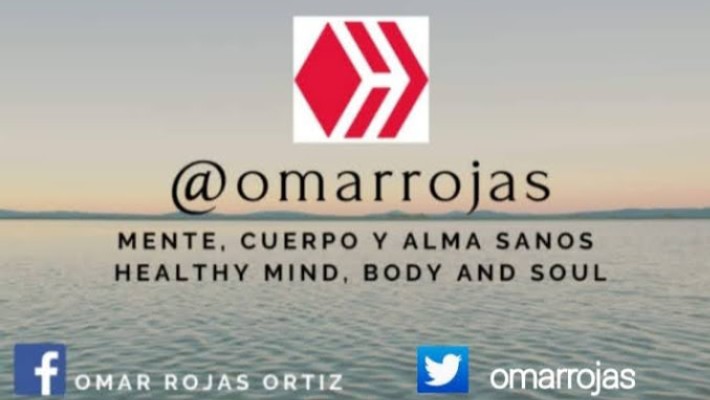
https://twitter.com/1325256276704686082/status/1588925393444442112
The rewards earned on this comment will go directly to the people sharing the post on Twitter as long as they are registered with @poshtoken. Sign up at https://hiveposh.com.
Excelente clase de meditación y relajación me encanta para después de tener un entrenamiento fuerte, buenísimo gracias, amigo @omarrojas por compartir.
Gracias estimada @genice antes de ejercitarnos a fondo, la meditación y el calentamiento es la clave mágica, para que todas las acciones que desarrollemos sean exitosas. Felicidades.
Wao la verdad es que se ve muy relajante,debería intentarla ahorita que va a empezar la semana
Me contenta estimado @blas-training que le haya gustado la presente postura, la cual es muy relajante. Éxitos en sus ejercitaciones y publicaciones.
Uno debe terminar como reseteado, me gusta los ejercicios donde hacemos contacto con el suelo y que más que terminar adoloridos terminamos relajados. Que buena explicación! saludos!
Gracias estimada @corinadiaz así es la relajación es una fase importante de calentar el cuerpo y hacer yoga, si no concluimos tranquilos y en paz, no tiene sentido, ejercitar el cuerpo no es para maltratarnos ni física ni mentalmente, pues no tendría sentido. Éxitos